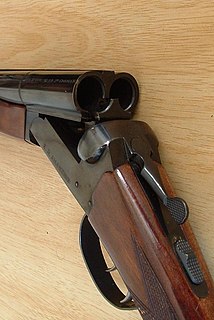
In firearms terminology, an action is the mechanism of a breech-loading weapon that handles the ammunition or the method by which that mechanism works. Actions are technically not present on muzzleloaders, as all are single-shot weapons with a closed off breech. Instead, the ignition mechanism is referred to
An air gun is any kind of gun that launches projectiles pneumatically with compressed air or other gases that are pressurized mechanically without involving any chemical reactions, in contrast to a firearm, which pressurizes gases chemically via an exothermic oxidation (deflagration) of combustible propellants which generates propulsive energy by breaking molecular bonds. Both the long gun and handgun forms typically propel metallic projectiles, that are either diabolo-shaped pellets, or spherical shots called BBs. Certain types of air guns may also propel darts or arrows.

BB guns are a type of air guns designed to shoot metallic ball projectiles called BBs — metal balls approximately the same size as the 0.180 inches (4.6 mm) "BB" lead birdshot. Modern BB guns usually have a barrel with a bore caliber of 4.5 mm (0.177 in) and are available in many varieties. These guns usually use steel BB shots, either zinc- or copper-plated to resist corrosion, and measuring 4.3 to 4.4 mm in diameter and 0.33 to 0.35 g in weight. Some manufacturers still make the traditional lead balls around 0.48 to 0.50 g in weight and slightly larger in diameter, which are generally intended for use in rifled barrels due to lead having better malleability.
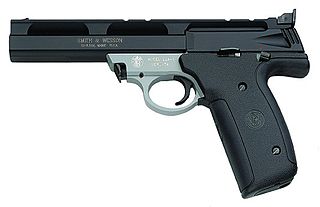
The Smith & Wesson Model 22A is a semi-automatic pistol that was manufactured in Houlton, Maine. The 22A is a full-size pistol with an aluminum alloy frame. The steel barrel has an integrated Weaver style rail.
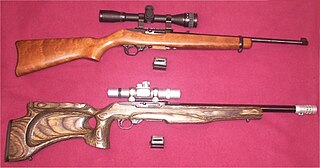
Accurizing is the process of improving the accuracy and precision of a gun.

The Beretta U22 Neos is a .22 Long Rifle semi-automatic, single-action pistol using a slide blow-back system, that has been manufactured in the United States since 2002 by Beretta USA. The pistol will accept interchangeable 4.5″, 6″ or 7.5″ barrels in blued or stainless steel finishes. Each barrel incorporates a built-in Weaver-style rail to accommodate optics or accessories. Beretta markets the Neos as a modern, reasonably priced pistol suitable for a beginner, yet is customizable to suit the experienced marksman.
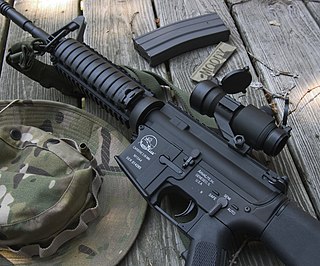
Airsoft guns are replica weapons used in airsoft sports. They are a special type of very low-power smoothbore air guns designed to shoot non-metallic spherical projectiles often colloquially referred to as "BBs", which are typically made of plastic or biodegradable resin materials. Air soft gun power plants are designed to have low muzzle energy ratings and the pellets have significantly less penetrative and stopping powers than conventional air guns, and are generally safe for competitive sporting and recreational purposes if proper protective gear is worn.

Daisy Outdoor Products is an American airgun manufacturer known particularly for their lines of BB guns. It was formed in 1882 initially as the Plymouth Iron Windmill Company to manufacture steel windmills, and from 1888 started bundling BB-caliber air guns with each windmill purchase as a sales promotion. With the unrivalled popularity of their 1888-model Daisy BB Guns, the company changed the name to Daisy Manufacturing Company in 1895 and switched their business to solely producing air guns for sale. Throughout the 20th century, Daisy has been known as a company that makes and sells BB and pellet youth rifles. Their Red Ryder BB Gun is perhaps the best known and longest production item, which has been featured in many TV shows and movies since its introduction in the 1930s.

The Tanfoglio Force, also known as Force 99, Force 2002, EAA Witness Polymer or EAA Witness P-Carry, is a modified clone of the Czech CZ-75/CZ-85 semi-automatic pistol. It is made in Gardone Val Trompia near Brescia, Italy by Fratelli Tanfoglio S.N.C..
The CCI Phantom is a Nelson-based pump action paintball marker developed and produced by Mike Casady. Production began in 1987 after about six months of prototype work. The name for the marker was derived from the much more stealth-oriented and drawn-out style of play that was typical when the game was first developing. The Phantom was designed to be powered by a single 12 gram CO2 powerlet, but larger tanks may also be used by removing the powerlet adapter or using a dummy powerlet. When first introduced the marker featured a fixed barrel assembly referred to as a "unibody" combined with a modified Crosman air pistol frame and brass bead sight. However, since roughly 1989 the body and barrel of the marker have been two distinct parts and no longer feature the bead style sight. The marker is also capable of supporting bulk gravity fed hoppers by using a different breech type. The Phantom is one of only a handful of readily available markers acceptable for use in the various forms of stock class paintball. However, because the Phantom is capable of auto-triggering and features barrel porting it is considered to be a modified stock class marker.
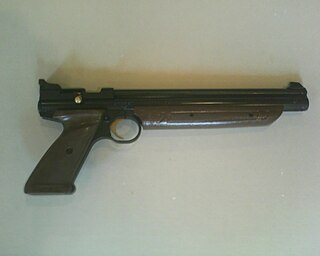
The Crosman model 1377 is a single-shot, bolt-action, pneumatic .177 caliber pellet gun, featuring a rifled steel barrel and imitation wood checkered plastic grips. The 1377 was introduced in 1977, and has been in continuous production ever since. A separately available shoulder stock converts the rather long pistol into a carbine. The 1377 is not a competition level target airgun, but its long rifled barrel makes it fairly accurate.
The Remington Model 30 is a US sporting rifle of the inter-war period based on the military P14/M1917 Enfield rifle action, which was manufactured for the British and US governments during World War I. Initial specimens used surplus military parts with some modifications in order to consume the stock of parts, though further modifications were made as production progressed and later rifles were produced from newly manufactured parts. Most early rifles were in the military .30-06 calibre used in the M1917 but it became available in a variety of chamberings. It was the first high-powered bolt-action sporting rifle produced by Remington.
The BSA Scorpion Air Pistol was an air pistol made in Birmingham UK by Gamo subsidiary BSA Guns (UK) Limited) and first produced in 1973. It was a spring powered, single-shot weapon available in .177 (4.5 mm) and .22 (5.5 mm) calibers. The Scorpion came in 2 versions, the Mark 1 and Mark 2, differences are not easy to spot as earlier models developed and changed but still remained designated Mk1's. The easiest way to differentiate between the various models is by the serial number prefix, located beneath the barrel joint.

The Crosman 2100B is an American-made pneumatic air gun that is manufactured for small game hunting, large and small pest control, and target shooting.
The Walther LGR air rifle was developed by the German arms manufacturer Carl Walther GmbH Sportwaffen as a high end match rifle for 10 metre air rifle competition shooting. The LGR was the first match air rifle that employed the then futuristic single-stroke pneumatic method as power source. This use of pre compressed air introduced the advantages of recoilless and vibration free shooting in combination with a well-made air rifle into the sport. It took other manufacturers a decade before they also introduced single-stroke pneumatic match air rifles.
The Winchester Model 1890 is a slide-action repeating rifle produced by the Winchester Repeating Arms Company in the late 19th and early 20th century.
The Crosman Pumpmaster 760, or Crosman 760 Pumpmaster, is an American-made multi-pump pneumatic Air Gun that is manufactured for target shooting, plinking, and small pest control. The Crosman 760 Pumpmaster is a BB gun with more than 16 million copies sold. It has a caliber of .177 and can shoot up to 645 fps for BBs and 615 for Pellets. Pellets are loaded into a 5-shot clip, while BBs have an 18-shot magazine, which is fed from the 200-shot reservoir. It comes standard with a fiber optic front sight, but can accommodate a scope on the 3/8 inch (9.5 mm) dovetail rail on top of the receiver. The rear sight is a notch sight and is adjustable for elevation using a 5-rail elevator piece.
The Weihrauch HW 35 is a break barrel, spring powered air rifle first produced in 1951, manufactured by Weihrauch & Weihrauch located in Mellrichstadt, Bavaria, Germany. It is available in .177 (4.5 mm) and .22 (5.5 mm) calibers, with standard and carbine (K) length barrels and has been in continuous production since its launch, even though the Weihrauch HW 80 superseded it in the late 1990s.
Sheridan Products Inc. was an American air gun manufacturing company. It was purchased by the Benjamin Air Rifle Company in 1977, and later purchased by Crosman in 1994.









